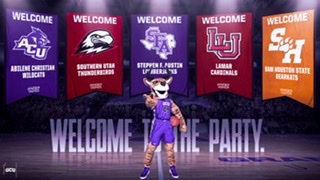Conference adds 5 programs aligned with Lopes’ upward model, basketball brawn
(Phoenix, AZ) Grand Canyon’s rapid development as a Division I athletic program vaulted forward with today’s Western Athletic Conference announcement that it will add five universities. The expansion brings strength and stability to the WAC and aligns with the conference profile of growing campuses, successful programs and dedicated athletic missions.
GCU and its WAC brethren will be joined for the 2021-22 academic year by the four strongest Southland Conference athletic programs in recent years – Abilene Christian, Lamar, Sam Houston State and Stephen F. Austin – as well as Southern Utah of the Big Sky Conference a year later.
“Particularly in basketball, GCU has had the makings of a top-20 program because of its incredible facilities, a game atmosphere that is second to none, a Power Five coaching staff, a competitive mid-major budget and a location as a destination city,” said GCU President Brian Mueller, who was instrumental in facilitating the WAC expansion as a representative of the WAC executive committee. “The last step was participation in a strong athletic conference and this expansion accomplishes that. This is a giant leap forward in our Division I journey.
“This is one of the biggest mid-major expansions in NCAA realignment history and puts the WAC in a very strong position moving forward.”
The WAC basketball status as a rising mid-major conference is bolstered by incoming programs that accounted for five of the past seven Southland men’s basketball champions and six of the past seven Southland women’s champions.
The additions will create a 13-member, two-division WAC with prospects of adding another member that aligns with raising the conference’s all-sports status. The four incoming Texas members have claimed 60% of the 14-member Southland Conference’s regular-season and postseason tournament championships in the seven years that all four have been in the Southland. Southern Utah brings five Big Sky titles from the past five years.
“The addition of these five institutions sets the WAC on a very exciting trajectory with members who are committed to being a premier mid-major conference,” GCU Interim Vice President of Athletics Jamie Boggs said. “A conference expansion of this magnitude takes extraordinary effort and collaboration and we are thankful to President Mueller, who played a key role in making this possible, to the WAC Board, to Commissioner Jeff Hurd and his staff, and to the presidents and athletic directors of the incoming institutions for making this happen. This move further positions GCU for competitive success on a national scale and we look forward to the future of the WAC.”
More than lifting the competition level and the depth with each tradition-rich program carrying at least 17 sports, the new WAC members are in high-growth areas that boast pleasant year-round weather and nearby metropolitan markets.
With six Texas members and three Utah members, the majority of the WAC will be housed in the nation’s two fastest growing states since 2010. In that same 10-year span, new member Sam Houston State has enjoyed a 23% enrollment growth to be in line with 10-year spikes at California Baptist (134%), Dixie State (31%), GCU (135%), Tarleton (600%) and Utah Valley (28%).
The expansion also will mean that the WAC has members located in or near five of the nation’s top 13 media markets. Being in those areas and rapidly growing Utah will enhance university exposure, increase recruiting territory and draw more recruiting attention to Phoenix-area high school student-athletes, including for the conference’s seven Football Championship Subdivision programs.
GCU will not add football, continuing with a conference-high 21 sports.
The restructured WAC would have changed the average national ranking for conference teams substantially in recent years. Over the previous three fully completed years, the average team ranking of the WAC’s future structure would have improved by 20 spots in men’s basketball, 45 spots in women’s basketball and 24 spots in baseball.
Average WAC travel will be reduced by 140 miles per intraconference trip with the groupings of six Texas universities and three Utah universities creating natural rivalries. Southern Utah and Dixie State sit 51 miles apart while Lamar, Sam Houston State and Stephen F. Austin lie within 130 miles of each other. Abilene Christian is a 95-mile trek from Tarleton.
Trips and competitions are more apt to go as scheduled in locales that boast an average high temperature in the 60s for November and February.
The basketball venues exemplify how the conference is larger. The five new members will have arenas, including planned renovations, with an average capacity of 6,354 fans. That aligns with five existing WAC members that play in arenas with seating for 4,779 to 12,572 fans, including 7,000-seat GCU Arena.
Press Release courtesy of Grand Canyon University – Josh Hauser
















